Growing up and now living in the predominately white city of Seattle, I’ve known and worked with countless White Americans. I have yet to meet one White American who has given or received “The Talk.”
You know, the one that primarily Black American families have to have with their children to keep them safe from the police – because of their race: “Keep your hands open and out in front of you, shut your mouth, be respectful, say ‘sir.’” The one you can now witness through this powerful video:
White Americans have the privilege to grow up without “The Talk,” but that doesn’t mean they should grow up without a talk.
Perhaps because too many White Americans never get one, they too often get race so wrong.
For one, a recent survey reveals that a startling number of White Americans – 55% – believe that they are the targets of discrimination. Other studies (here and here) have corroborated such high percentages. Important to note about this recent survey is that “a much smaller percentage” of those White Americans say that they actually experienced the discrimination.
Before you start blaming Trump supporters for these results, a pre-election poll of 16,000 Americans revealed that Clinton supporters, too, have some serious work to do. For example, 20% of Clinton supporters described Black Americans as “less intelligent” than White Americans.
Racism is a problem all across the board for White America, even in “progressive” places like Seattle.
Maybe this deep misunderstanding of racism explains why too many White Americans don’t lift a finger to stop it. Literally. Most White Americans – 67% – refuse to even click to share articles about race on social media.
We White Americans are long past due for a “Talk” of our own. I’ve even readied some talking points for you.
Before I lay them out, I’d like to note that I’m hardly the first to compile such a list. However, given white peoples’ attitudes and inaction on racism, another article certainly can’t hurt and could even help. Compare my list to this one, this one, or this tasty one. (It will only help me make my point.)
It’s worth adding to this wealth of existing information because many White Americans still hold on to what they think are legitimate reasons to dismiss information about systemic racism against people of Color.
You may think such reasons are valid, too. You might believe that the evidence of systemic racism is “anecdotal,” argue that sources are “out of date,” or feel skeptical about information from op-eds or radical lefty publications.
So you should know that, for this one article, I’m sticking with numbers, not stories. Also know that, for the most part, I’m citing publications only from the last few years and from mainstream news publications, government or academic studies/data, or coverage of such studies/data from mainstream news publications. As much as possible, I’m staying clear of left-leaning sources like The Huffington Post, which initially covered the Trump campaign in its Entertainment section.
While reading, keep two key numbers from the Census in your head:
- 62: the percentage of this country that is White American (not Latinx)
- 13: the percentage of this country that is Black American
If access to institutional power were spread proportionally, 13% of Black Americans and 62% of White Americans would make up any given institution.
Finally, I focus primarily on disparities between Black Americans and White Americans for two reasons. First, the disparities between these demographics are often the most extreme – making them harder to deny. Second, White Americans are most frequently targeting the Black Lives Matter movement in their pushback. Does any data justify this pushback?
Let’s examine why it doesn’t. Here are the talking points for “The Talk” that White Americans urgently need to have.
1. Primary and Secondary Education
The US Department of Education recently found that Black preschoolers are 3.6 times more likely to be suspended than White preschoolers. Preschoolers. Representing 19% of preschoolers, Black children make up half of all preschool suspensions.
And these disparities continue throughout their schooling. Here’s data from Seattle Public Schools, even several years after the Department of Education launched an investigation into the district’s treatment of Black students.
Given these disparities, it’s no surprise that large gaps in achievement and representation in advanced classes for Black and White students persist.
And the predominately white teaching force – 90% white in Washington state – invariably plays a role. The Washington Post reports that “Black students are half as likely as white students to be assigned to gifted programs, even when they have comparably high test scores.” That disparity disappears when the teacher is Black.
2. Higher Education
According to the Pew Research Center, 69% of all bachelor degrees are held by White Americans. While Black enrollment in universities has “skyrocketed” in the past twenty years – despite the bleak disparities of public education – Black Americans make up only 6% of enrollment at “top-tier” universities.
Census reminder #1: It should be 62% and 13% – not 69% and 6%.
“The Talk” for White Americans must include an honest discussion about education. The narrative of our educational system as leveler of the playing field doesn’t hold up with a racial lens.
3. Employment
Because education level correlates to employment opportunities, educational disparities have narrowed and color-coded the pool of employment applicants. And race continues to matter for those who remain.
The New York Times has compiled multiple studies over the past twenty years that all confirm that White Americans’ race benefits them in the process of gaining employment – like the study from 2009 that found Black applicants without criminal records fared as well in getting hired as White applicants with criminal records.
But I promised more recent research. The Washington Post asserts that Black Americans are twice as likely to be unemployed as White Americans – a statistic that was true back in 1954. If you include incarcerated Americans, Black Americans are nearly three times as likely to be unemployed.
The disparities extend to household income. According to CNN, the average household income for White Americans is $71,300. For Black Americans? Just $43,300. And they extend to homelessness as well. One study found that, in 2010, Black families were seven times more likely to stay in a homeless shelter than White families.
Not only is the poverty rate of Black Americans (26.2%) more than 2.5 times that of White Americans (10.1%), Black Americans are “much more likely” to live in concentrated poverty, which means they have less access to the coveted schools that drive housing purchases. The Atlantic tracks these poverty rates in the following graph:
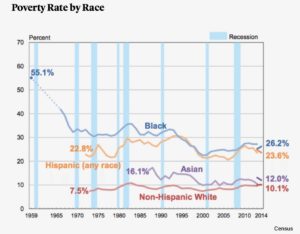
And if you noticed the absence of data for Native people in the above graph, the poverty rate for “American Indians and Alaska Natives” is the highest of any racial group: 27%.
“The Talk” for White Americans must include an honest discussion about employment and poverty. The narrative of hard work leading to riches doesn’t hold up with a racial lens.
4. Criminal ‘Justice’ System
Since I just mentioned incarceration, let’s dig into that pile of data. The Prison Policy Initiative reports that in 2014 Black Americans made up 40% of the incarcerated population in the US; White Americans made up just 39%. (Census reminder #2: 13 and 62, respectively, are the population percentages.)
To frame it another way, Black men are six times more likely to be incarcerated than White men, according to the Pew Research Center. BET confirms that the same is true for Black women when compared to White women. (I could not find data from a mainstream source about incarceration rates of queer women or non-binary people, which is telling.)
But I know those disparities don’t convince everyone of institutional racism. After all, Black Americans could commit more crimes, right?
Well, not if you start with drug use. In our federal prisons, 46% are incarcerated because of drug offenses. Yet a 2013 government survey of 67,500 people revealed that White and Black Americans use drugs at similar rates (9.5% and 10.5%, respectively).
Isolate heroin use, and the picture shifts dramatically. The New York Times reports that “nearly 90% of those who tried heroin for the first time in the last decade were White.”
But the injustice of mass incarceration isn’t just about who ultimately gets locked up. Racial disparities pervade every step of the process leading to incarceration (as well as those that follow it).
That includes police stops, police searches, police use of force, arrests, pre-trial incarceration, prosecution charges, conviction rates, prison versus community service sentences, length of sentencing, parole access, hiring rates after incarceration, and voting disenfranchisement. (Okay, that was my one Huffington Post source – but a damn important one.)
Vanity Fair recently compiled eighteen studies on racial bias in law enforcement and concludes, “the research paints a picture of a nation where a citizen’s race may well affect their experience with police.”
Just as many White people are now arguing that the heroin epidemic is a “disease” and not a crime, we don’t have to use the criminal justice system to address “the myriad of social needs” that Black Americans face, as Ta-Nehisi Coates highlights in this short video:
“The Talk” for White Americans must include an honest discussion of a system that, according to Ava DuVernay, evolved from slavery. The narrative of our system as a “justice” system doesn’t hold up with a racial lens.
5. Wealth
Comparing wealth leads to the most extreme disparities. Here’s a new number to remember: sixteen. According to Forbes, a typical White household has sixteen times the wealth of a Black household.
And this is where history matters (and you don’t even have to go back very far). Here’s a two-minute crash course on the discriminatory housing practices that played a large role in today’s wealth disparities, giving White Americans a head start and only allowing Black Americans into the race when real estate had appreciated beyond an affordable cost for too many:
CNN reports that, based on current trends, “it will take 228 years for black families to accumulate the same amount of wealth” that White Americans have today.
While we like to think of education as the answer to these disparities, new research shows that even the benefits of a college degree come color-coded. According to The New York Times, from 1992-2013, “the median net worth of blacks who finished college dropped nearly 56%.” In contrast, the net worth of White Americans who finished college climbed nearly 86%.
“The Talk” for White Americans must include an honest discussion about this country as a meritocracy. That narrative of education as a pathway to social mobility doesn’t hold up with a racial lens.
6. Housing
The rate of home ownership for White Americans is 73% and for Black Americans is 45%, and is explained in part by the video above. Like with the criminal “justice” system, bias is documented in many of the steps in the home-buying process.
Forbes uncovers that Black people tend to receive higher interest rates and that Wells Fargo admitted to pushing Black households into subprime mortgages.
The New York Times reports that, when applying for conventional mortgages, one in four Black Americans are denied, compared to one in ten for White Americans.
And for those who actually make it to the house hunt, a $9 million study of 28 metropolitan areas found that “[c]ompared with white homebuyers, blacks who inquire about homes listed for sale are made aware of about 17% fewer homes and are shown 18% fewer units.”
“The Talk” for White Americans must include an honest discussion about housing discrimination – past and present. The narrative of housing as part of the American dream doesn’t hold up with a racial lens.
7. Health
What does systematic racial oppression do to the health of the Black population? A 2012 study – for the most part, before viral videos of police killing Black Americans filled our newsfeeds – found that Black Americans report “experiencing discrimination at significantly higher rates” than other racial or ethnic groups, leading to PTSD-like symptoms – not from war, but from living in the United States.
According to NPR, a social epidemiologist at the University of California, Berkeley, found in studying Black women “that chronic stress from frequent racist encounters is associated with chronic low-grade inflammation – a little like having a low fever all the time.”
Unfortunately, if you are Black, your doctor may be ill-equipped to treat you. The Washington Post recently compiled several studies that document racial bias in health care – including one that found “whites are more likely to be prescribed strong pain medications for equivalent ailments.” NPR attributes many of these disparities to the “unconscious biases” of the doctors.
“The Talk” for White Americans must include an honest discussion about the toll of racism. It also must include a discussion about inequities in health care. The narrative of doctors fulfilling their Hippocratic Oath doesn’t hold up with a racial lens.
8. Media Representation
Vanity Fair writes that, of the top grossing films of 2014, 73.1% of the speaking roles went to White Americans, while just 12.5% went to Black Americans. (Reminder #3: 62% and 13%.) This overrepresentation of White people in Hollywood has led to two straight years of the #OscarsSoWhite hashtag.
Media representation is a category where other groups of Color can fare worse than Black Americans. For example, Latinx Americans – 17.6% of the population (some of whom are Black) – make up just 4.9% of speaking roles.
Even though diverse casts translate to box-office success, according to NPR, representation in our media remain stubbornly White – from the cast to the creators:
But numbers are only part of the issue. The types of roles available also matter, and many groups of Color find the menu of opportunities quite limited (with color-coded, lower paychecks to match), which might explain Viola Davis’s 2015 Emmy acceptance speech: “The only thing that separates women of color from anyone else is opportunity.”
“The Talk” for White Americans must include an honest discussion about the media we consume. With a racial lens, the narratives of some people barely exist.
***
Given this deluge of data, is it possible that you as a White American are systemically oppressed?
Well, I never want to tell another person what their experience is. After all, that seems to be the primary strategy of All Lives Matter folks and meninists: denying the oppression of others.
Is it possible that a White American remains stuck in concentrated poverty because of their race, gets targeted by the police because of their race, gets a shitty education because of their race, can’t get a fair shot at a top university because of their race, can’t get a fair shake at a good job because of their race, can’t get access to good housing or health care because of their race, and can’t find anything to watch aside from Empire, Fresh Off the Boat, Master of None, and Luke Cage?
I suppose anything is possible, but it sure as hell doesn’t seem likely.
In critiquing the profound anti-blackness throughout this country’s history, Robin DiAngelo puts it another way: Black Americans have never had the power to systemically commit the atrocities that White Americans have committed – and continue to commit – against them:
It is not an understanding of reality or history that leads to those high percentages of White Americans who report feeling oppressed.
Far more likely, White Privilege has warped our understanding of our current system – a system that, according to all the data, we desperately and collectively need to break.
“We keep saying the system is broken, and it’s not. The system works exactly the way it’s supposed to. So instead of saying ‘the system is broken, let’s fix it,’ we should be saying ‘the system is working, let’s break it.’” —Marc Lamont Hill
We need to break it so that – together – we can rebuild a more just one.
Ultimately, that’s “The Talk” that White Americans need to be having.
A version of this piece was originally published in Everyday Feminism. For more ways to act against racism, check out the Roads to Racial Justice series.

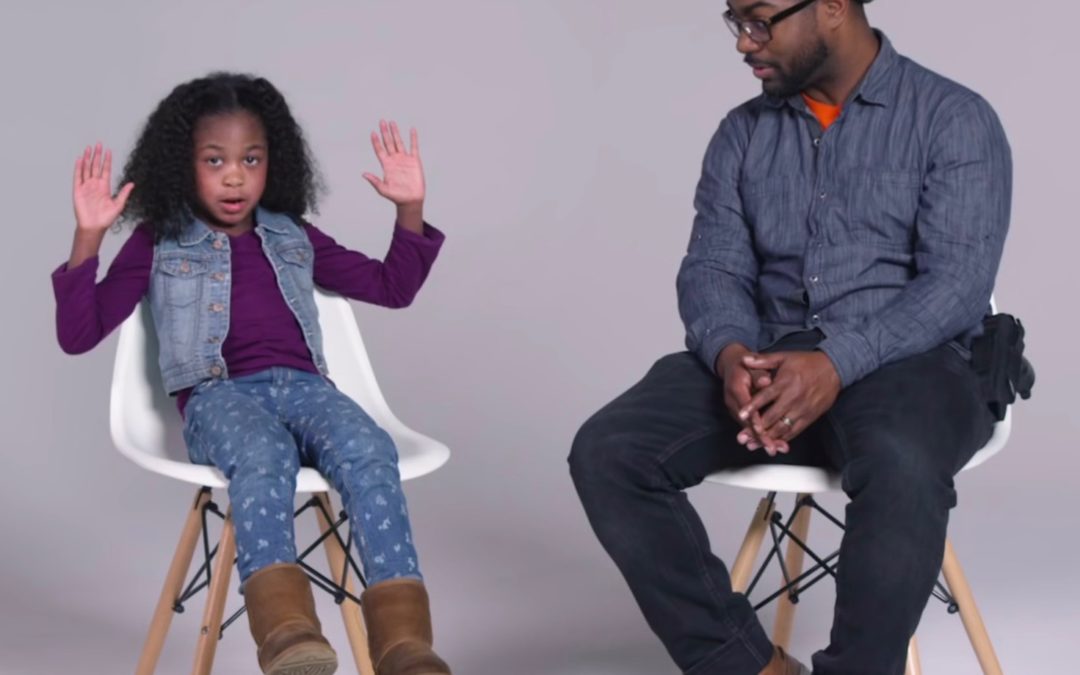
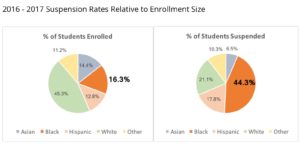
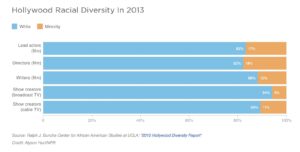

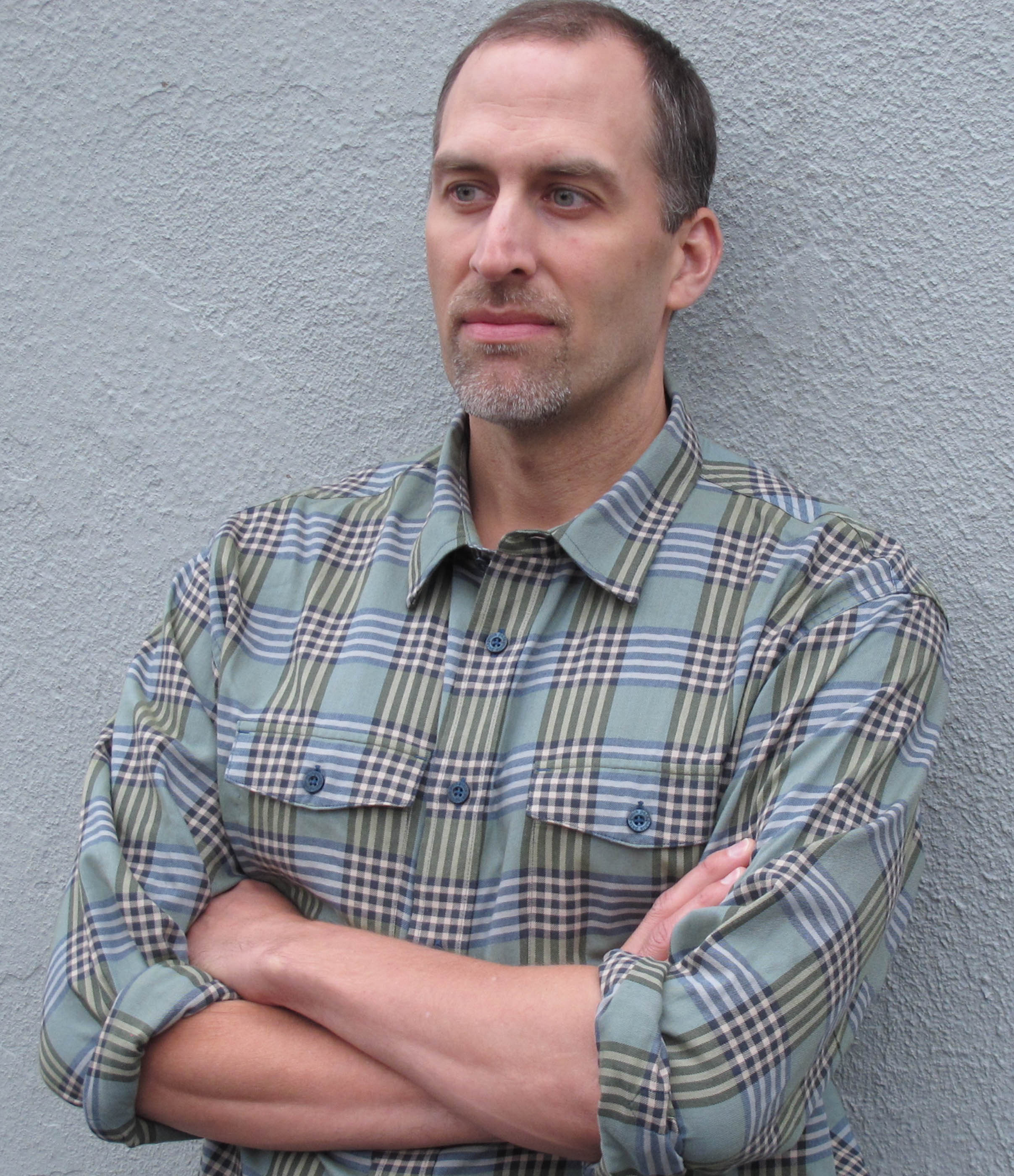




Thank you Jon, for such a succinct accessible article and the videos to go with it. I am a white woman and trying to wake up to unearned privileges I’ve had simply because of the color of my skin. I am now in my early 60’s and remember the civil rights and women’s rights movements that swept across this nation. Time for another round and this time, because of social media and articles such as these, and cell phones that can record the aggression of those in power to those who are again and again disenfranchised, perhaps we can wake up a bit more.
I echo the words of Ms. Henschel-McGerry above, Jon, thank you! I shared this piece on every social media format I’m connected with because I found it so clear.
I’m in my 70’s and half Spanish. I came from a seriously twisted background and the only decent, loving people I knew – and could trust – were the various black folks my family hired to care for us… and if my parents thought I was getting too close to them,they showed them the door.
I grew to trust black and brown people and be constantly wary of white folks… I was totally ignorant about racism as a general trend until I was in college and was exposed to the marches for integration via the TV news… and I had no idea until this pitiful excuse for a human took up residence in DC of the real picture of what has been going on in this country apparently for way longer than I’d ever imagined… and that people have known! Even supported it!
I feel like such a fool… and I’m angry as hell at the same time. I admire your composure and your patience and I am grateful for good information that I can share… because now that I have been exposed to the extent of this madness… I am sharing all the common sense goodness that I can.
Thank you, Jon, for all your work and dedication. I appreciate the comments above by Cathy and Victoria. I too am in my mid-seventies and have tried to grapple with this embedded racism I inherited. I will post this on my Facebook and forward it to friends. It is a long road of redirecting our thinking and behaviors – but it begins with me.